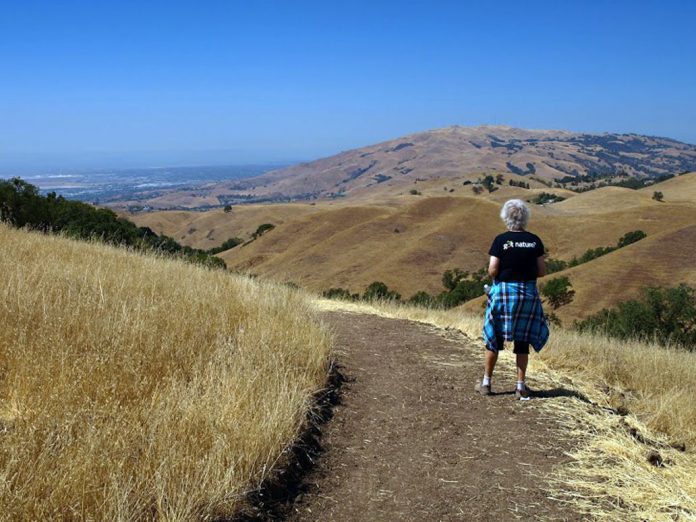Virginia Holtz grew up in Washington State and at a young age lived in a log house in a state park not far from Seattle. Her father was the caretaker of the park and her grandparents were farmers. Holtz’s childhood was spent outdoors; she recalls seeing the local Native Americans fishing for eels and watching tadpoles grow legs and become frogs. When she married and moved to Santa Clara County in 1979, she was shocked at the rapid, unplanned development going on all around her. In contrast, people in Washington seemed to place a high priority on open space, parks, lakes and farmland.
John Fioretta grew up in the San Fernando Valley and learned to love the outdoors on Boy Scout camping trips. In 1985 he moved to San Jose and, on his days off, enjoyed exploring the hiking and biking trails near his home. Within a couple of years, however, some of those trails disappeared as the hills sprouted homes and shopping centers. San Jose, he realized, was turning into Los Angeles.
These two individuals, and a number of others—all regular people, working regular jobs and living regular lives—saw what was happening to our valley and hillsides and were appalled. San Mateo County and northwestern Santa Clara County had the Mid-Peninsula Open Space District. The East Bay had the East Bay Regional Parks District. Why couldn’t central and southern Santa Clara County protect its open spaces?
In 1986, the City of San Jose commissioned the Hillside Greenbelt Study and Holtz represented the Parks and Recreation Commission on the committee to study the issue and make recommendations. Concurrently with the county’s Preservation 2020 committee, the two groups recommended the creation of an open space agency. Fioretta became involved in 1987 when he attended a meeting of the Greenbelt Alliance, which later joined forces with other preservation organizations to focus their joint efforts on the creation of an open space agency.
Other volunteers became involved, including Garnetta Annable, Kitty Monahan, then-Greenbelt Alliance staff member Vicki Moore and many more. Others who worked tirelessly on this project, including Supervisor Dianne McKenna and her aide, John Gibbs, Supervisor Susie Wilson, Jerry Estruth and Mike Honda. Years later, many of these people went on to hold positions with the Open Space Authority or the OSA Citizen’s Advisory Committee.
Between 1988 and 1992, the proposal to form an open space agency was heard by the state legislature several times. In 1992, a bill was finally passed and signed by then-Gov. Pete Wilson, authorizing the creation of the Open Space Authority of Santa Clara County. But there was one major drawback—the bill provided no funding.
A measure to assess each parcel of land in participating cities and in unincorporated Santa Clara County $20 per year to fund an open space agency had been on the ballot in November 1990. Under Proposition 13, the measure required a two-thirds majority vote to pass. Although 64.1 percent of voters had approved it, the measure failed. So when the state legislature finally created the Open Space Authority, but didn’t fund it, and a prior ballot measure to fund it had been defeated, it would have been easy to give up in disappointment and frustration.
Where was the money necessary to operate this agency going to come from?
Fortunately, the OSA’s founders were dedicated and determined. In 1994, eight long years after the City of San Jose and the County of Santa Clara recommended creation of an open space agency, a benefit assessment measure permitting a $12 per year parcel assessment was approved by the voters. Nearly all the cities in Santa Clara County not within the Mid-Peninsula Regional Open Space District voted to join the newly formed Open Space Authority. Morgan Hill joined, as did unincorporated Santa Clara County. The first property purchased by the OSA was on Palassou Ridge, east of Gilroy.
Since then the Open Space Authority has preserved more than 16,000 acres of open space in Santa Clara County, including vital wildlife corridors, creeks and watersheds, working farms, urban open space and scenic hillsides, including Coyote Ridge, which provides habitat for the threatened bay checkerspot butterfly. Coyote Ridge is spectacular for its abundance of spring wildflowers and the diversity of wildlife, including elk, bobcats, badgers, coyotes, golden and bald eagles, horned larks, prairie falcons and American kestrels.
None of these important conservation efforts would be happening today if not for the tireless efforts of some ordinary people who got together and did an extraordinary thing. Their story is a lesson about the power of a group of committed and passionate individuals who had a vision of how our local world can be a better place, now and for our children and grandchildren.
Paraphrasing Abraham Lincoln, Fioretta said: “The closest you can get to immortality is to preserve something that outlasts you.”










